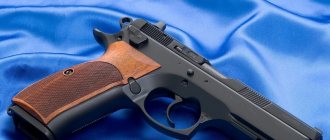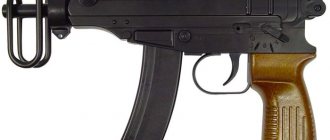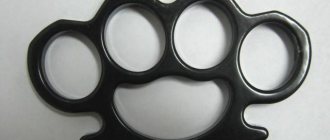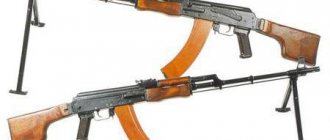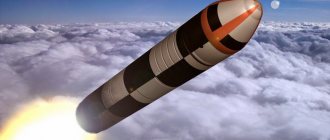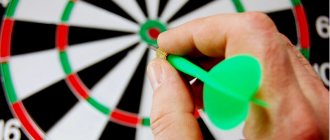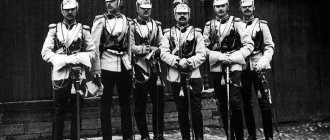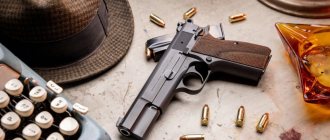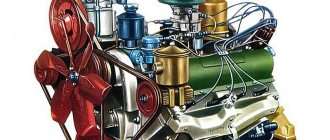Czech: original and gone through a long historical path. Part 2
In general, the Germans came up with a fairly simple, convenient, cheap and technologically advanced weapon. Suffice it to say that thanks to the use of stamping and welding, the cost of the new machine gun compared to the StG-44 decreased by 25 Reichsmarks (now it cost 45 marks versus the previous 70 - the difference, as you can see, is noticeable), and in addition, from 14 to 7, 4 hours, that is, the manufacturing time of one machine has almost halved. But the war ended before the Sturmgewehr 45(M) gained widespread acceptance and acceptance. Mostly specialists knew about it. Moreover, even today all sorts of speculations continue to be written about him, or let’s say, they write about the obvious, keeping silent about everything else. Therefore, today we will tell you about all this “rest”.
Automatic Sturmgewehr 45(M).
Today, wherever you look on the Internet, the following text appears: “The first samples used automation based on a gas engine and rigid locking of the barrel using a pair of rollers, similar to that of the MG 42 machine gun, but the scheme was too complex.” Now let’s re-read this passage again and ask ourselves, what kind of ignoramus (you can’t find another word!) wrote all this? Well, what kind of gas engine did the MG 42 have, when this machine gun operates on the principle of recoil of the barrel during its short stroke? Now we read further: “Before firing, the bolt, under the pressure of the return spring, is in the extreme forward position, displacing the rollers from the bolt with its front beveled part into the grooves in the barrel coupling. At the moment of firing, the combat larva begins to move backward under the pressure of powder gases to the bottom of the cartridge case. The rollers installed in the cylinder are carried along behind it, pressing into the bolt and forcing its beveled front part to move backward relative to the combat cylinder. The main energy of the powder gases is spent on accelerating the most massive bolt. By the time the pressure in the barrel drops to acceptable values, the rollers are completely “retracted” into the bolt, after which the entire bolt group moves back, removing the spent cartridge case and feeding a new cartridge into the chamber on the way back.”
. Surprisingly, everything that is written and highlighted here is written quite correctly and... incorrectly at the same time.
Czech poster depicting Sa vz. 58.
Device vz.
58. At the bottom left you can clearly see what parts the bolt group consists of. On the right is the gas exhaust mechanism. It would be more correct to write that for this type of machine gun, the bolt consists of two parts (or parts) - upper and lower, which, if desired, and due to tradition, can be called a combat cylinder. The British call this part the bolt head and, it seems to me, this is more correct. Then we have the upper and lower parts of the bolt and this lower part has a head. There are two rollers in the head. The upper and lower parts of the shutter are movably connected. But there is no “beveled front part of the bolt”. There is a rod through which the striker passes and which enters the cylinder (lower part), and this rod has side bevels in its profile, and when it moves into the cylinder, they actually press on the rollers and push them apart sides. But the rollers themselves do not retract into any shutter. They are retracted inside the combat cylinder, or into the lower part of the bolt! Its upper part is really massive, cylindrical in shape and is connected to the return spring rod. At the bottom of the combat cylinder there are two protrusions that slide along the grooves of the receiver. Therefore, the shutter moves strictly horizontally. By the way, the grooves for the rollers are also made in the receiver.
Czech Army soldiers with vz machine guns. 58.
CZH 2003 Sport. Limited production in Canada. Option with a barrel extended to 490 mm.
Right view. The maple leaf is a sign that this model was made in Canada.
Then everything seems to be clear. When a shot occurs, the powder gases press on the bottom of the cartridge case, and through it on the combat cylinder. To facilitate the operation of the mechanism, in the place where the rifled part of the barrel begins, there are grooves (Revelli grooves) that divert some of the gases to the walls of the cartridge case, which ensures its better extraction. And, yes, when the gas pressure in the barrel drops to an acceptable value, both rollers are recessed into the cylinder and it, together with the bolt, moves back, and then moves forward again by force due to the force of the spring.
Standard military model. Left view.
Standard military model. Right view.
However, it is not written anywhere why such a massive, even seemingly metal casing on the barrel is needed. After all, it turns out that all the automation is in the receiver! So why does the Sturmgewehr 45(M) also need this “decoration”? But why: there’s a gas venting mechanism hidden there! The hole in the barrel is closed by a spring-loaded rod. But the most interesting thing is that this rod is not connected to the bolt in any way, but serves only to relieve excess pressure and the barrel. Well, gases come out of three holes on top of the lid. I wonder why no one wrote about this interesting feature of this machine? They didn’t know what was hidden under that cover and how it worked?!
This is what the bolt group looks like when pulled back. The extractor and firing pin are clearly visible. Please note that the front of the receiver does not have a cover. The shutter closes it.
And this is the extended barrel of the Canadian model.
Further, everything that is written is quite acceptable: the trigger on it is truly a trigger type, which makes it possible to fire both single shots and bursts. The firing mode selector (and the safety switch) is located on the left side of the receiver, as is the bolt handle. The butt is wooden and located in line with the barrel in a “linear pattern”, which reduces barrel toss, but forces the sights to be raised high above the barrel. By the way, it’s also bad that on the Sturmgewehr 45(M) they are too far forward and away from the shooter’s eyes. They should have been placed on the back of the receiver cover, but for some reason the Germans didn’t do this. It turned out that due to the long sector magazines with 30 rounds of ammunition, a problem arose with increasing the shooter’s profile when shooting prone, and in order to solve it, a special shortened magazine with a capacity of 10 rounds had to be developed for the rifle.
Handguard and receiver lining.
And this is how they are removed. Interestingly, the mounting pins are not completely removed, so they cannot be lost!
Well, then the German engineers who took part in the creation of the StG45(M) found refuge in France and began working for the French arms company CEAM. From 1946 to 1949, Ludwig Forgrimler and his colleague Theodor Löffler created three variants of the new machine gun chambered for .30 Carbine, 7.92x33 mm and 7.65x35 mm. France eventually received the CEAM Modelo 1950 assault rifle, and Forgrimler, already in Spain, working for the CETME company, designed the CETME Modelo A rifle. Subsequently, it was the StG 45 that served as the basis for the HK G3 automatic rifle, which appeared in Germany in 1959, and the submachine gun HK MP5, while in Switzerland they began to produce the SIG SG 510 rifle using a similar scheme.
Gas piston.
A gas piston extended from a gas tube.
And here’s an interesting question: did the Czech designers get acquainted with this type of weapon or not? In any case, the system with a piston on the barrel was known to them, and they implemented it in their vz.52 rifle. How about a roller shutter retarder? In any case, one thing is certain: when engineer Jiri Cermak from Brno began work on his machine gun in 1951, he borrowed a lot from other models of small arms known at that time, but in the end he tried to go his own way. Of course, he knew the Kalashnikov assault rifle. But... somehow his design did not satisfy the Czech designer.
One of the features of vz. 58 is the presence of two springs - the return bolt - it is at the top, and the combat spring - the firing pin, it is at the bottom.
He worked hard, persistently and consistently. First, he developed the ČZ 515 assault rifle chambered for the Czechoslovak cartridge 7.62×45 mm vz. 52. It had a shortened barrel from a vz rifle. 52, firing from an open bolt (this was the requirement of the army, which feared self-ignition of cartridges in the chamber during intense shooting), and a trigger mechanism with a trigger from the German MG 34 machine gun, which, depending on pressing the upper or lower part of it, turned on either a single or automatic fire.
Fully assembled assault rifle bolt.
During testing of the machine gun, it was found that the ČZ 515 did not meet the requirements for shooting accuracy imposed on weapons by the Czechoslovak Army. It was believed that the reason was that the fire was fired from an open bolt. Then Cermak made the ČZ 522 assault rifle, which had the same trigger mechanism, but the shooting was carried out from a closed bolt, and the gas release mechanism had a gas piston that acted on the bolt. In 1954, the ČZ 522 and two other prototypes (from competing design teams) were tested by both the Czechoslovak Army and the Soviet Army in the USSR. During this testing, Soviet experts found that all three machines needed improvement, but the ČZ 522 was considered the best among them.
View of the shutter from below. The striker rod with longitudinal grooves and the swinging cylinder with protrusions are clearly visible.
The third option was also initially planned for our own Czechoslovak cartridge, since it had already been used in the Vz rifle. 52 and in a light machine gun with the same designation. But the USSR considered it necessary to standardize the small arms of its ATS allies, so the prototype of the “Koště” assault rifle (that is, “Broom” in Czech) was made for the Soviet intermediate cartridge 7.62 × 39 mm M43, used in the SKS carbine and in Kalashnikov assault rifle. In 1958 it was given the designation Sa vz. 58 and were adopted by the army of Czechoslovakia, after which over the next 25 years they produced more than 920 thousand copies. The machine gun came into service with the armies of Czechoslovakia, Cuba, as well as a number of countries in Asia and Africa.
The lower part of the bolt with a U-shaped swinging cylinder placed on it.
True, the initial model of the machine gun weighed 3.2 kg, which was more than the weight set by the army and equal to 3 kg. Then a magazine made of aluminum alloy was developed for it, which achieved the desired weight reduction. By the way, even the weight of the AKM assault rifle was greater than the original weight of the Chermak assault rifle. True, the designers had to tinker with the problem of self-ignition of cartridges in the chamber during intense shooting, which usually occurred at the 180th shot. However, it was eventually resolved.
A firing pin extended from the bottom of the bolt.
The machine was designed in a rather original way and only externally resembled a Kalashnikov assault rifle. Chermak began to abandon the gas exhaust engine, but its gas piston is in no way connected to the bolt. It has its own return spring and when fired, it strikes the bolt frame with a strong blow, pushing it back. By the way, this phrase found on the Internet - “To provide the required push to the bolt group, the piston could move only a few centimeters” - does not correspond to reality, or rather is not very accurate. The piston moves back only 19 mm, while the release of powder gases occurs after a passage of 16 mm.
The bolt group (this is the best name for this set of parts) consists of a bolt frame with a reloading handle (or the upper part of the bolt group), a lower part, a U-shaped swinging cylinder and a firing pin with longitudinal grooves. And it is precisely this swinging larva at the bottom of the bolt that plays the main role in the barrel locking system. When the piston hits the bolt frame and throws it back, it moves 22 mm (at the same time, only the upper part moves back, while the lower part still locks the bore!) and here the wedge-shaped surface of the bolt frame presses on the cylinder, causing it to disengage with receiver lugs. The lower part of the bolt group rises up and moves back together with the upper part, as a result of which the spent cartridge case is ejected and the firing pin is cocked.
Stock model CZ858.
As for the trigger mechanism, yes, it is striker-type. The firing pin is located inside the lower part of the bolt group with the ejector, and behind it there is a coiled mainspring, which is put on a rod in the rear wall of the receiver. There are grooves on the striker so that it can move along the guides inside the above-mentioned part. There is a tooth at the bottom that engages with the sear when the weapon is cocked. There is no striker on the firing pin. It only hits it during each shot, and the firing pin is located in the lower part of the bolt frame.
That is, in principle, the gas exhaust mechanism was not needed. A short barrel stroke or roller deceleration like the Sturmgewehr 45(M) would be sufficient. But a bayonet was needed, so the barrel was fixed rigidly.
Aim.
The machine's sights consist of a front sight and an adjustable rear sight, which allows you to hit targets at a distance from 100 to 800 m in increments of 100 m, both in daylight and in the dark.
Shop.
The machine was equipped with box-shaped sector magazines for 30 rounds of lightweight plastic. After the last shot, the bolt remained open until a new magazine was inserted. The magazine latch was located on the left at the base of the receiver. The ejector is at the base of the magazine receiver. It was also possible to use 10-round clips (similar to those used in the SKS). At the same time, vz stores. 58 are incompatible with magazines of AK family assault rifles.
Magazine neck.
The stock, handle and forend were first made of wood, and then of an unusual material - plastic mixed with wood shavings! A bayonet-knife could be attached to the machine gun, and on some samples also a bipod and an under-barrel grenade launcher. Weapons made in Czechoslovakia were distinguished by traditionally high quality workmanship. All parts of the shutter, the gas piston and the barrel bore were chrome plated, and the outer surfaces of the metal parts were phosphated. In addition, to protect against corrosion they were coated with a special varnish.
One of the upgrade options is vz. 58.
Automatic vz. 58 was equipped with various accessories: for example, double-sided fire selectors could be installed on it, the forend could have a different configuration, and muzzle brakes and compensators could be installed on the barrel. All this was installed on both military and civilian models of the machine gun: soldiers from various private military companies were usually equipped with such accessories. The machine is also sold with four spare magazines and a bag for them, a bayonet with a scabbard, a cleaning brush, a muzzle cap, a bottle of gun oil, a unified belt, a tool for adjusting the sight, a bipod and a device for firing blank cartridges.
To be continued…
Ceska Zbrojovka Ch3-22
Josef Nickel developed this pistol for the German company, but they refused to produce it. When Nikel, accompanying a batch of new equipment, ended up at an arms factory in Brno, he learned that the Czechs were looking for a new model of pistol, and stayed in Brno to introduce his development. The design of his pistol, with a rotating barrel and a locked bolt, was complex, and the pistol turned out to be expensive. Although a new version was introduced in 1922, the company produced only about 35,000 Ch3-22s and ceased production in 1926. Unfortunately, the 9mm Pattern 22 cartridge used was not widely used.
Czech Zbrojovka Ch3-27
Despite the comparative success of the Ch3-24 model, its complex design required simplification. Designer Frantisek Myszka took on the solution to this problem. The result was the Ch3-27 model, similar in appearance to the Ch3-24, but radically different in internal structure. This is a conventional blowback pistol chambered in 7.65mm. It was simpler and cheaper to produce than Ch3-24. After the occupation of Czechoslovakia by Germany, the Ch3-27 pistol was adopted by the German army under the designation “Pistole 2727 (t).”
Czech Zbrojovka Ch3-83
The Ch3-83 pistol, introduced in 1983, has a blowback action and a double-action trigger mechanism. Thanks to automatic safety locks, the hammer can only function when the trigger is fully depressed. The safety catch is double-sided and there is also a magazine safety. In the former Czechoslovakia, the Ch3-83 model was in service with the security forces. Due to its compactness, the pistol could be used in covert operations and for self-defense. Ergonomics, caliber and light weight made this weapon very convenient.
Czech Zbrojovka Ch3-24
The Ch3-24 pistol became an improved model of the Ch3-22. This pistol managed to achieve what the Ch3-22 did not achieve - it was adopted by the Czechoslovak army. In appearance, the ChZ-24 differed slightly from its predecessor (for example, the magazine release button was different), the main difference was the caliber - the Ch3-24 was chambered for the more popular 7.65 mm cartridge (.32 AKP). Production began in June 1926 at the new facility, and by 1937 approximately 190,000 of these pistols had been produced. However, the weapon's complex mechanism remained expensive and labor-intensive to produce. To some extent, this drawback was overcome in the Ch3-27 model.
Ceska Zbrojovka Ch3-85
This model, an improved modification of the Ch3-75 model, began to be produced in the mid-1980s. It features an automatic firing pin lock, which prevents accidental firing when the pistol is dropped, and a two-way manual safety. The design of the pistol allows you to hold it equally comfortably with your right or left hand; the handle with rubber cheeks is ergonomic. The sights are equipped with three luminous dot inserts. The combat version of this pistol has an adjustable rear sight.
Ceska Zbrojovka Ch3-50
At the end of the 1940s, the Czechoslovak Ministry of the Interior ordered a new pistol based on the Walter PP model. The main design features of the Walter PP, including the double-action trigger mechanism, have been preserved, albeit in a slightly modified form. The pistol was unremarkable and not very reliable, but remained in production until the end of the 1960s, until the development of the Ch3-70 pistol that replaced it was completed.
Czech Zbrojovka Ch3-38
Although this double-action pistol, introduced in 1936, was a good quality pistol, it was difficult to shoot with one hand and required a lot of force to pull the trigger due to the self-cocking mechanism. The physical effort required made accurate shooting difficult. However, the pistol could be easily disassembled and cleaned thanks to a hinge in the muzzle of the weapon, with the help of which the barrel and bolt were tilted up. The pistol was produced in limited quantities and was not in service with the Czechoslovak army.
Czech Zbrojovka Ch3-52
This pistol was first released in 1952. A pistol with a locked bolt and a short barrel stroke, the locking of which was carried out using rollers diverging to the sides. After disengaging the barrel and bolt, the bolt continued to roll back, ejecting the spent cartridge case and chambering a new cartridge as it returned to its original position. The weapon is equipped with a three-position safety and can be carried with a round in the chamber.
Ceska Zbrojovka Ch3-70
The Ch3-70 model was developed with one goal: to get rid of the problems caused by the unreliability of the Ch3-50 pistol. The dimensions of the internal parts of the mechanism were changed, as well as some construction materials. There were also differences in appearance between the Ch3-50 and Ch3-70 - in the latter model there is a round hole in the trigger spoke, while in the former the trigger is solid; the pistol was produced from 1970 to 1984.

